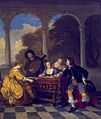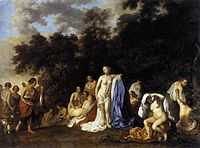Jacob van Loo

Jacob van Loo (1614 – 26 November 1670) was a painter of the Dutch Golden Age. Van Loo is known for his conversational groupings, his use of a subtle color palette and his nudes. He was the founder of the Van Loo family of painters.
Biography
Van Loo was born in the Flemish town Sluis, which had been occupied by the Dutch Republic since 1604. Some sources have speculated that his father, Jan van Loo, may have been a notary,[1] but more often his father is described as a painter from whom Jacob van Loo received his early training. Little is known of Van Loo's early history due to the destruction of the city archives in Sluis during World War II.

His early influences included Thomas de Keyser and Jacob Adriaensz Backer. In 1642, van Loo moved to Amsterdam, where his contemporaries included Rembrandt, Frans Hals, and Bartholomeus van der Helst. In 1643 he married Anna Lengele, the sister of the painter Martinus Lengele (1604–1668). The couple had six children.[2] They lived on Rozengracht in the Jordaan district of Amsterdam. Eglon van der Neer became one of his pupils. In 1660, Van Loo fled the city after fatally stabbing someone during an altercation at an inn. He was sentenced to death in absentia which forever prevented his return to the Dutch Republic.[3] Van Loo settled in Paris, where he was admitted to the Académie de peinture et de sculpture. He died in Paris in 1670.
Van Loo's work was done in the Baroque style that had originated in Rome and popular throughout Europe. He was a major influence on Johannes Vermeer as can be seen in Vermeer’s painting, Diana and Her Companions.
Van Loo painted many portraits. Among his subjects were Johan Huydecoper van Maarseveen; his sister, Leonara Huydecoper, who was married to Jan J. Hinlopen; Joan Ortt, who was later involved with Antoinette Bourignon; and his wife Lucretia Boudaen.
Jacob van Loo's son, Louis Abraham van Loo, was also a painter, as were his grandsons, Jean-Baptiste van Loo and Charles-André van Loo.
Gallery
-

Meebeeck Cruywagen Family, c. 1640-45.
-

A concert.
-

Melancholy
-

Young woman going to bed, c. 1650.
-

Naked man and woman, 1650s.
-

Diana and her Nymphs, 1654.
-

Portrait of a gentleman, 1668.
References
- ↑ Blankert, A. (1999) Hollands Classicisme in de zeventiende-eeuwse schilderkunst, p. 164.
- ↑ Web Gallery of Art
- ↑ Loo, Jacob van at the Netherlands Institute for Art History.
External links
| Wikimedia Commons has media related to Jacob van Loo. |
- Record at Getty Research
- Biography from Kresge Art Gallery
- Biography at Daphne Alazraki Fine Art
- Works and literature on Jacob van Loo
|
